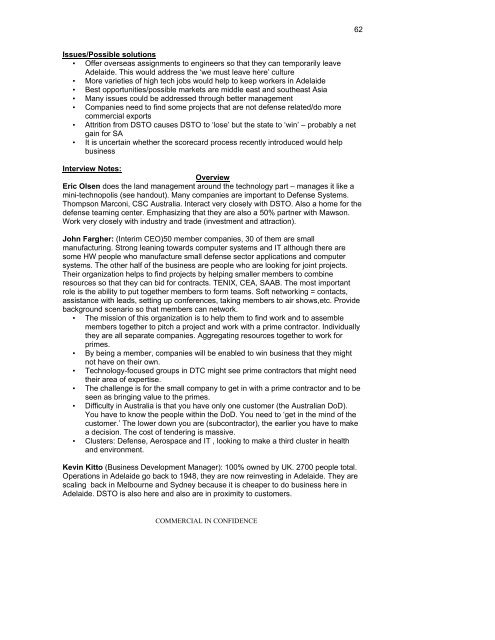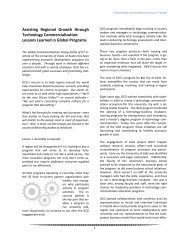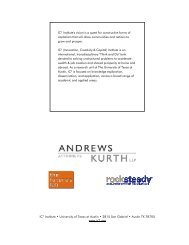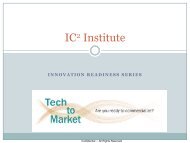“Quicklook” Assessment of Greater Adelaide's Assets & Challenges ...
“Quicklook” Assessment of Greater Adelaide's Assets & Challenges ...
“Quicklook” Assessment of Greater Adelaide's Assets & Challenges ...
Create successful ePaper yourself
Turn your PDF publications into a flip-book with our unique Google optimized e-Paper software.
Issues/Possible solutions<br />
• Offer overseas assignments to engineers so that they can temporarily leave<br />
Adelaide. This would address the ‘we must leave here’ culture<br />
• More varieties <strong>of</strong> high tech jobs would help to keep workers in Adelaide<br />
• Best opportunities/possible markets are middle east and southeast Asia<br />
• Many issues could be addressed through better management<br />
• Companies need to find some projects that are not defense related/do more<br />
commercial exports<br />
• Attrition from DSTO causes DSTO to ‘lose’ but the state to ‘win’ – probably a net<br />
gain for SA<br />
• It is uncertain whether the scorecard process recently introduced would help<br />
business<br />
Interview Notes:<br />
Overview<br />
Eric Olsen does the land management around the technology part – manages it like a<br />
mini-technopolis (see handout). Many companies are important to Defense Systems.<br />
Thompson Marconi, CSC Australia. Interact very closely with DSTO. Also a home for the<br />
defense teaming center. Emphasizing that they are also a 50% partner with Mawson.<br />
Work very closely with industry and trade (investment and attraction).<br />
John Fargher: (Interim CEO)50 member companies, 30 <strong>of</strong> them are small<br />
manufacturing. Strong leaning towards computer systems and IT although there are<br />
some HW people who manufacture small defense sector applications and computer<br />
systems. The other half <strong>of</strong> the business are people who are looking for joint projects.<br />
Their organization helps to find projects by helping smaller members to combine<br />
resources so that they can bid for contracts. TENIX, CEA, SAAB. The most important<br />
role is the ability to put together members to form teams. S<strong>of</strong>t networking = contacts,<br />
assistance with leads, setting up conferences, taking members to air shows,etc. Provide<br />
background scenario so that members can network.<br />
• The mission <strong>of</strong> this organization is to help them to find work and to assemble<br />
members together to pitch a project and work with a prime contractor. Individually<br />
they are all separate companies. Aggregating resources together to work for<br />
primes.<br />
• By being a member, companies will be enabled to win business that they might<br />
not have on their own.<br />
• Technology-focused groups in DTC might see prime contractors that might need<br />
their area <strong>of</strong> expertise.<br />
• The challenge is for the small company to get in with a prime contractor and to be<br />
seen as bringing value to the primes.<br />
• Difficulty in Australia is that you have only one customer (the Australian DoD).<br />
You have to know the people within the DoD. You need to ‘get in the mind <strong>of</strong> the<br />
customer.’ The lower down you are (subcontractor), the earlier you have to make<br />
a decision. The cost <strong>of</strong> tendering is massive.<br />
• Clusters: Defense, Aerospace and IT , looking to make a third cluster in health<br />
and environment.<br />
Kevin Kitto (Business Development Manager): 100% owned by UK. 2700 people total.<br />
Operations in Adelaide go back to 1948, they are now reinvesting in Adelaide. They are<br />
scaling back in Melbourne and Sydney because it is cheaper to do business here in<br />
Adelaide. DSTO is also here and also are in proximity to customers.<br />
COMMERCIAL IN CONFIDENCE<br />
62





